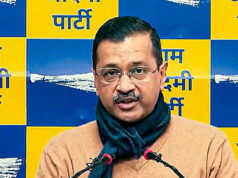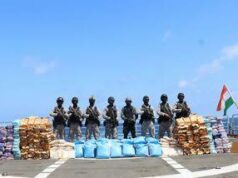Those Who Wield The Surgical Knives Along With The Surgical Strikers Of The Indian Army
By Colonel Awadhesh Kumar, Veteran Special Forces
75 Glorious Years Of Maroon Docs. They have always been side by side with the paratroopers. They were in Korea ,in Kashmir, in Poonch in Goa , in Bangladesh , in Siachin ,in Kargil , in Srilanka, in Maldives, in Badrinath earth quake , in Kathmandu earth quake…….they will always be there wherever Paratroopers land.
THE FIRST PARATROOPER
Raising of the 50 Parachute Brigade commenced in October 1941 in New Delhi. The following units became part of this Parachute Formation :
(a) 151 British Parachute Battalion
(b) 152 Indian Parachute Battalion
(c) 153 Gurkha Parachute Battalion
(d) 411 Royal Bombay Parachute Section ( Engineers)
The first Indian officer to report on posting to this new brigade was Lieutenant A G Rangaraj. He was posted as the Regimental Medical Officer of 152 Indian Parachute Battalion. Soon he became the FIRST INDIAN PARATROOPER.
Lt Rangaraj did his para training at the Air Landing School( ALS) along with his Havildar Major Mathra Singh . This School was newly established around that time near the Wellingdon Airport , New Delhi. There were 8 RAF officers , 5 British Army Officers , 4 RAF Parachute Jump Instructors and few Other Ranks from the Army along with a handful of parachute packers from British / Indian Army.
The first of the experimental parachute jumps in India was carried out on 15 October 1941 in Karachi airfield by three British Officers……Flight Lt Brereton, Capt Abbot and Capt Hopkinson. Due to Pilot error all three landed on the tarmac and sustained serious injuries. The first Parachute Basic Course commenced in November 1941 at the ALS , the Drop Zone was just west of the present day Delhi Cantt. The jumps were done from Vickers Valencia , a two engined aircraft with a top speed of 125 Km per hour. Due to its slow speed and its shape it had the nick name of FLYING PIGS. These aircrafts had no seats and every had to sit on the floor. At the centre there use to be a big hole. On “RED ON” the first paratrooper had to sit there with his leg dangling in the hole , looking at the dispatcher. On “GREEN ON “ as soon as the Dispatcher brought his hands down , shouting G…o….ooo, the paratrooper just vanished in the hole…..next chap then followed. One had to be quite careful about the position of his head or risk a solid knock on the jaws from the aircraft floor. A few missing teeth always happened in every course. After 5 day jumps , a soldier qualified as a paratrooper and was awarded a parachute wings. In the fifth jump one had to jump with a container that had the paratroopers weapon, ammunition and all his stores and equipment.
The first Airborne exercise by the Brigade was carried out in Feb1942 , near the Hindon river. However due to certain problems, for the actual jump only one aircraft was available and so only one STICK of 10 paratroopers could be dropped ( rest of the brigade moved to DZ by vehicles). This jump had the first of the ROMAN CANDLE and the Paratrooper died on the spot, two others sustained serious injuries.
The Air Landing School moved to Chaklala in October 1942 and it became the No3 Para Training School. It started conducting standard courses of 14 days duration with each batch numbering 30 students. From April 1943 , Wellingtons aircraft became available for para training and so the batch size increased to 60 and night jumps too was introduced as the fifth jump. The jump height was kept at 700 ft. Those days every course at Chaklala had at least one fatal incident. In one case of ROMAN CANDLE , a miracle happened. The paratrooper after hitting the ground was still breathing and at the hospital it seen that he not even sustained any fracture. After long
deliberations , the jump height was increased to 1200ft and parachute packing and its maintenance got standardised. Finally fatal incidents came to a halt and even jump injuries became minimal.
By 1951 the first Indian Paratrooper was now a Lt Colonel , commanding 60 Parachute Field Ambulance. He along with a surgical team of his unit Jumped with 4000 men of the 187th Airborne Regiment of US Army , as part of UN Forces. It was a Combat Jump at 0900h about 40 km NW of Munsan near Seol in Korea.

A total of 102 paratroopers had suffered serious injuries during the jump ( 10 very badly) and were looked after by Colonel Rangaraj and his team for the entire duration of the battle which lasted for seven days. The team also looked after another 300 soldiers who got wounded during the battle. Col Rangaraj was awarded with a Mahavir Chakra for this battle.
For the Korean war Lt Col AG Rangaraj and Major NB Bannerjee were awarded the Maha Vir Chakra, seven others won the Vir Chakra and six officers, six JCOs and 13 Jawans were mentioned in dispatches. Among the Vir Chakra awardee was Major A Rangaswamy , Vr Chakra who now received a bar to his earlier Vir Chakra won in 1947-48 in Kashmir. All those who jumped in combat in Korea were also awarded American Parachute Wings. After Jun1951 , 60 Para became part of the Commonwealth Division and treated a total of 1800 battle casualties and 9000 other injured and sick. The second team functioning on the Line of Communication performed 1000 operations and treated another 25000 civilians. The unit which spent three winters in Korea was singled out for praise in the British House of Commons. 60TH also received a MERITORIOUS UNIT CITATION from the US Army and the South Korean Army.

60 Para Field Ambulance also received a trophy from the President of India , from Dr Rajendra Prasad at a Special ceremonial parade held at Agra on 10 March , 1955. It was a great honour ,conferred on a unit for the first time in the history of the Indian Army.
The Nepal Army too gave a citation to the unit……the first international response team…..for the wonderful work done during the 2015 Nepal Earthquake.
Raised in 1942 under command Lt Colonel Bisdee. 60 th had served in Burma before its conversion to the para role and transferred to 44 Indian Airborne Division in 1945. 60 Parachute Field Ambulance joined the 50 Independent Parachute Brigade some time in 1950. Earlier it had served with distinction during the 1947- 48 war in Kashmir. Lt Col A G Rangaraj took over command from Aug 1947 to May 1949 and again from Apr 1950 to Mar 1953. Later Lt Col A Rangaswami , Vir Chakra* took over the Unit . There is an URBAN LEGEND that when Rangaswami got promoted to the rank of Brigadier , seeing his overall performance and also his performance on Staff College Course at Wellington, the C-In- C had given a very very serious thought to offering him command of an Infantry Brigade

Captain Bose , Indian Medical Services , had just joined the 50 Para Brigade about end August 1942. When suddenly GHQ asked the brigade to provide a medical officer for a Special Mission to help out a large party of refugees making its way out of Hukawang Valley in Burma. The mission was urgent….help was required by a large number of women and children , too weak with disease and malnutrition. However all para trained doctors were already deployed and none of them could be recalled in time for the mission. Capt Bose having just joined had not even done his parachute basic course. Bose who was a married man with a young family , volunteered at once unhesitatingly when told about the urgency , importance and also the dangers of the mission. Even his young wife supported him A quick and short course was arranged and within a few days he parachuted into Burma behind the Japanese lines. Bose did an excellent work but unfortunately he died while crossing back the mountains. No one knows how. Today we do not even know his first name. May be after reading this some one in Kolkata or other parts of West Bengal or even Bangladesh may be able to give his first name.

On 20 Sep 1966 , Captain Farida Rehana of this Unit completed her 5th and final jump to become the First Female Paratrooper of the Indian Army. Much later Major N Linyu followed in her footsteps to become an accomplished Combat Free Faller . She also went on to climb Mt Everest as part of an Army Expidition.
Such are our doctors and medical staff who join the army and on top of that volunteer for the maroon beret. During recent times 60 was in the forefront during the natural calamity at Badrinath . They were the first to reach Nepal after the devastating earthquake. The Govt of Nepal was full of appreciation for the Unit. The Koreans still remember this unit and 6
As on date , Director General Armed Forces Medical Services Lt General Manoj K Unni also wears the Maroon Beret , a Parachute Wing and a BALIDAN Badge, an old Regimental Medical Officer of 9.He will finally lay down his office on 31 Oct 2017.




